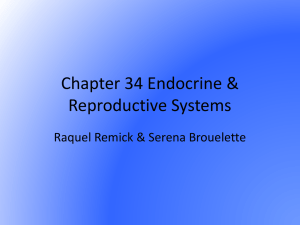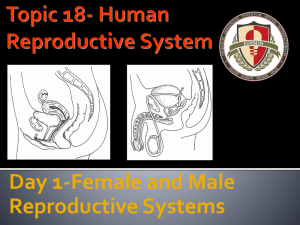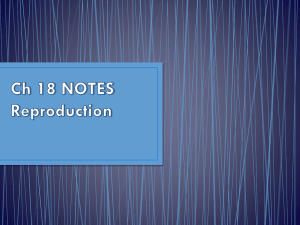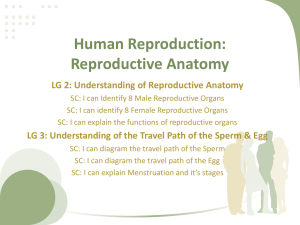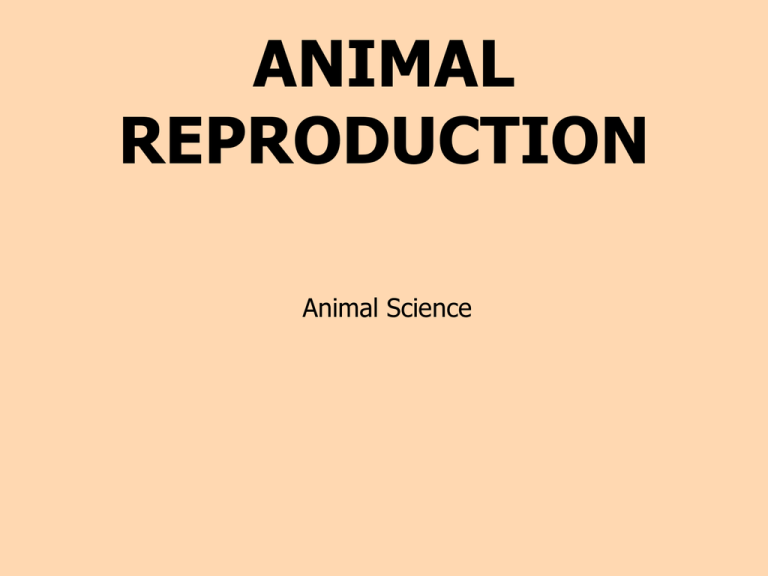
ANIMAL
REPRODUCTION
Animal Science
Introduction
Reproduction is the process by
which animals produce offspring
for the purpose of continuing the
species.
Photo by Ron Nichols courtesy of USDA Natural Resources Conservation Service.
The process of reproduction begins
with copulation, which is the mating
of a male and female of the species.
Sperm cells from the male are
deposited in the female reproductive
tract and try to unite with an egg cell.
When fertilization (a sperm cell and
egg cell unite) occurs, an embryo
begins to develop.
The embryo attaches to the wall of
the uterus where it is protected,
receives nourishment, and develops.
When the new offspring reaches the
end of the gestation period, it is
delivered from the female
reproductive tract in a process called
parturition.
To completely understand the
process of reproduction, a basic
knowledge of the reproductive tract
structures and functions is required.
Structure and Function of the
Male Reproductive System
Photo by Scott Bauer courtesy of USDA Agricultural Research Service.
The major functions of the male
reproductive system include:
• Production, storage, and deposition
of sperm cells,
• Production of male sex hormones,
• Serve as passageway for expelling
urine from the urinary bladder.
The male reproductive system is
made up of several organs, glands,
and muscles; each will be discussed.
Male Macrostructure and Function
Testes and Related Structures:
Testes – paired, ovoid shaped
organs that produce sperm cells
and testosterone.
Testosterone – the male sex
hormone that is responsible for the
development of secondary male
characteristics and sex behavior
(libido).
Spermatic cord - a protective
fibrous sheath consisting of smooth
muscle, blood vessels, and nerves.
Cremaster muscle – primary muscle
supporting testes and coursing the
length of the spermatic cord.
Scrotum – sac outside the body
cavity that protects and supports
the testes.
The spermatic cord extends from
the body through the inguinal ring
to suspend the testes within the
scrotum.
The cremaster muscle, spermatic
cord, and tunica dartos muscle
raise and lower the testes to
maintain a constant temperature
(4 – 6 degrees below body
temperature) for sperm to develop.
Epididymis and Related Structures:
Epididymis – a coiled tube connected
to each testis that is responsible for
the maturation, storage, and
transport of sperm cells.
Deferent Duct (Vas Deferens) – part
of the spermatic cord that is the
passageway for sperm from the
epididymis to the urethra.
Ampullae – an enlargement of the
deferent duct that opens into the
urethra and may serve as a
temporary storage depot for sperm.
Urethra – a passageway for both
semen and urine that extends from
the ampullae and bladder to the
end of the penis.
Accessory Glands:
The accessory glands are responsible
for the production of secretions
that contribute to the the liquid
non-cellular portion of semen
known as seminal plasma.
Semen and ejaculate are terms
given to the sperm plus the added
accessory fluids.
Vesicular glands (seminal vesicles) –
paired accessory glands that secrete
seminal fluid that nourishes the
sperm and provides protection and
transportation medium for sperm
upon ejaculation.
Prostate gland – secretes thick,
milky fluid that mixes with seminal
fluid to provide nutrition and
substance to the semen.
Bulbourethral glands (Cowper’s
glands) – secretes fluid that cleanses
and neutralizes the urine residue that
can kill sperm cells in the urethra.
Penis and Related Structures:
Penis – the organ that allows for the
deposition of semen into the female
reproductive tract.
The penis of the stallion is vascular,
which means that it depends on the
engorgement of blood within certain
tissues for erections to occur and it
forms no sigmoid flexure when
relaxed.
The penises of the bull, ram, and
boar are fibroelastic, which means
that they are primarily composed of
connective tissue and depend little
on blood for erections.
The rear portion of the fibroelastic
type penis forms an S-shaped curve
or sigmoid flexure when relaxed.
Retractor penis muscle – muscle
that contracts to retract the penis
and form the sigmoid flexure and
relaxes to extend the penis upon
sexual excitement.
Sheath – external portion of the
male reproductive tract that
serves to protect the penis from
injury and infection.
Male Microstructure and Function
Microscopic cellular parts within
the testes produce sperm cells and
testosterone.
Spermatogenesis refers to the
development of sperm cells
(spermatozoa) through a process
of cell division and maturation.
Seminiferous Tubules – tubular
structures that coil throughout
the testes and are the site of
spermatogenesis.
Spermatozoa (sperm cells) –
haploid gametes of the male that
are motile and tadpole-like.
Photo by Keith Weller courtesy of the USDA Agricultural Research Service.
Once matured, the sperm cells
proceed to the epididymis where
they are stored until ejaculation or
absorbed by the body.
Unusual climatic conditions
(extremely high temperatures) or
stress on the male can temporarily
halt sperm cell production causing
reproductive failure upon breeding.
Interstitial Cells (Cells of Leydig) –
group of cells between the
seminiferous tubules that produce
testosterone.
Testosterone – an androgen
hormone that directs the
development of secondary male
characteristics and influences
libido.
Secondary male characteristics
include coarse hair, horns that are
long and large at the base, a deep
voice, and pronounced muscularity.
Photo from IMS.
Structure and Function of the
Female Reproductive System
Photo from IMS.
The functions of the female
reproductive system include:
• Produce egg cells (ova),
• Serve as receptacle for the
penis during copulation, and
• House and nourish the fetus
until parturition.
The female reproductive system is
made up of several organs with
specific functions; each will be
discussed.
Photo from IMS.
Female Macrostructure
and Function
Ovaries – paired structures that
produce eggs (ova) and the female
hormones, estrogen and
progesterone.
Broad ligaments – ligaments that
support the female reproductive tract
and arteries, veins, and nerves of the
ovaries in the abdominal cavity.
Oviducts (Fallopian tubes) – paired
tubes that transport the eggs from
the ovaries to the uterus and serve
as the site where sperm and ova
meet and fertilization occurs.
Infundibulums – two funnel-like
openings of the oviducts that pick
up the eggs at ovulation and direct
them to the body of the oviducts.
Uterus – a major reproductive organ
that consists of the uterine body and
two uterine horns.
The embryo attaches to uterine body
or uterine horn, depending on the
species.
The uterus varies in shape between
livestock species from long uterine
horns of the sow to relatively short
uterine horns in the mare.
Functions of the uterus include:
• Passageway for sperm during
copulation,
• Incubation and nourishment of the
embryo during pregnancy, and
• Expulsion of the fetus during
parturition by contractions.
Vagina – reproductive structure
that serves as the receptacle for
the penis during copulation and
the birth canal at parturition; it
also serves as a passageway for
expelling liquid wastes, as the
urethra joins the bladder to the
vagina prior to the opening at
the vulva.
Cervix – a thick-walled mass of
connective tissue with a small tubelike opening that joins the uterus to
the vagina; it serves as a passageway
for semen during copulation.
It also contains glands that secrete a
waxy-like substance that seals off the
uterus during pregnancy and between
heat periods to protect against
infection, disease, or foreign matter.
Vulva – the external portion of
the female reproductive tract that
serves to protect the internal
system from infection, to initially
receive the penis at copulation,
and to act as a passageway for
urine.
Clitoris – a sensory erectile organ
just inside the vulva.
Female Microstructure
and Function
Oogenesis is the process of producing
ova (eggs) in the follicles of the
ovaries.
Oogonia cells develop in the ovaries of
the fetus and mature into oocytes by
birth.
Only a small proportion of oocytes
develop into ova or reach ovulation.
Follicle – a blister-like mass on the
surface of the ovary that contains a
developing ovum and produces and
stores estrogen.
The follicle secretes estrogen as a
signal to the rest of the reproductive
tract to prepare for ovulation
(release of the ovum from a mature
follicle).
Corpus hemorrhagicum – a small
hemorrhage or blood-clotted area
that develops at the site of a
ruptured follicle and lasts 2 – 3 days.
Corpus luteum – a yellow body of
cells that develops in place of the
corpus hemorrhagicum and produces
progesterone.
Progesterone – the female sex
hormone that functions to prepare
the female reproductive system for
pregnancy; it is produced by the
corpus luteum and lasts about twelve
days, unless the ovum is fertilized.
Corpus albicans – a white body of
connective tissue that is the result
of the degeneration and
re-absorption of luteal tissue.
Oogenesis is part of the estrous cycle.
The number of ova produced per
cycle varies with each species.
A cow or mare normally produces
one ovum per cycle.
A ewe produces two ova per cycle.
A sow produces eight to fifteen ova
per cycle.
Structure and Function of
the Reproductive System
in Poultry
The reproductive
anatomy of poultry
differ when
compared to that of
other animal species.
Male Reproductive System in Poultry
The male poultry anatomy consists
of two testes (each with an
epididymis and vas deferens) that
lead to papillae and a rudimentary
copulatory organ.
Male Poultry Reproductive Tract
Unlike other livestock species, the
testes of poultry are located within the
abdominal cavity along the backbone.
The epididymis, which still functions in
sperm storage, is relatively small in
relation to the testes.
The vas deferens extend from the
epididymis to the cloaca and are
located on each side of the vertebral
column.
The vas deferens extend from the
epididymis to the cloaca and are
located on each side of the
vertebral column.
The vas deferens function in
transportation of sperm and as
sperm reservoirs.
Cloaca – the lower end of the
avian digestive tract that provides
a passageway for products of the
urinary, digestive, and reproductive
tracts.
Papillae – located at the end of the
vas deferens and on
` the floor of the
cloaca, the papillae emit semen into
the cloaca of the female.
Phallus – a rudimentary copulatory
organ that becomes engorged with
lymph during mating, which allows
semen to be deposited onto the
female’s everted cloacus; the phallus
is more developed in ducks and geese.
Androgen – the male sex hormone
produced by the testes.
Functions of androgen include:
• Directing sexual activity and the
production of sperm,
• Controlling secondary sexual
characteristics of the male, and
• Influencing social rank or “peck
order.”
Secondary sexual characteristics of
include comb growth, crowing or
gobbling, spur development, and
male feathering.
Female Reproductive System in Poultry
The functional parts of the female
poultry reproductive tract includes
one ovary, an oviduct, and the
cloaca.
Female Poultry Reproductive Tract
Mature female poultry have only
one functional ovary; the right
ovary and oviduct degenerate
and cease functioning before the
bird reaches sexual maturity.
The ovary appears as a cluster
of tiny, gray balls that are the
oocytes.
At maturity, the ovary contains up
to 4,000 tiny oocytes from which
ovum may develop over time.
An ovum develops by collecting
lipid particles from the blood to
form the yolk.
The yolk contains fat for energy
and some protein and other
nutrients needed by the developing
embryo, as well as, a small white
dot called the blastodisc that
contains the genetic information
supplied by the female.
When mature, the yolk is released
by the follicle and engulfed by the
infundibulum.
The oviduct is about 25 inches long
and consists of five parts: the
infundibulum, the magnum, the
isthmus, the uterus, and the vagina.
Infundibulum – funnel-like part of
the oviduct that receives the yolk
and is the site of fertilization.
Magnum – second part of the
oviduct that secretes the thick
white or albumen.
Isthmus – third part of the oviduct
that adds the two shell membranes.
Uterus – the fourth part of the
oviduct that secretes the thin white,
the shell, and the shell pigment.
Vagina – the last part of the oviduct
that holds the egg until it is laid.
From the oviduct, the egg passes
to the cloaca and then out of the
body through the vent at the time
of laying.
In addition to producing ova, the
ovary produces the female sex
hormone, estrogen, and the
hormone androgen.
The androgen hormone stimulates
comb growth and works with other
hormones in egg production.
In poultry, the functions of estrogen
include:
• stimulating the growth of the oviduct,
• increasing the size of the cloaca
during egg laying,
• modifying feather shape and
pigmentation of the female, and
• increasing the level of fat, phosphorus,
and calcium in the blood.
The Reproductive Process
in Mammals
The estrous cycle is measured as
the time between two consecutive
estrous periods.
The duration of the estrous cycle
varies among species of livestock
(cow, sow, and mare is 19-21 days;
ewe is 15-17 days).
The estrous cycle begins with the
ovulation of a follicle and ends with
the ovulation of the next follicle.
When it erupts, the follicle releases
the egg to the oviduct and develops
a corpus hemorrhagicum.
The corpus hemorrhagicum last 2-3
days before it is replaced by the
corpus luteum.
The corpus luteum secretes the
hormone progesterone, which
helps prepare and maintain the
reproductive tract for pregnancy.
If fertilization of the egg occurs,
the corpus luteum remains for the
duration of the pregnancy.
If fertilization does not occur, the
corpus luteum regresses.
During the regression of the corpus
luteum, a new developing follicle on
the ovary begins to release estrogen.
In addition to preparing the
reproductive tract for ovulation,
estrogen induces estrus (heat) in
the female.
Estrus – the period of time when a
female animal is receptive to the
male for mating purposes.
Duration and Signs of Estrus
Species
Cow
Mare
Sow
Ewe
Duration
Signs of Estrus
12-24 hours Most reliable sign of estrus is
standing to be mounted.
4-9 days
Urinate frequently, vulva
winking, nervousness.
24-72 hours Standing still if pressure is
applied to loin area.
24-36 hours Standing to be mounted by ram.
After ovulation, the egg (ovum) is
received by the infundibulum and
funneled to the oviduct.
If a female has been bred during
estrus (heat period) and a viable
sperm reaches the fallopian tube to
fertilize the egg, pregnancy occurs.
As mentioned, the corpus luteum
remains throughout pregnancy to
produce progesterone.
Progesterone prevents an estrus
period during pregnancy, helps to
implant and nourish the embryo,
and helps to develop the mammary
system of the female.
Fertilization – the union of the
haploid sperm and the haploid
ovum to form a diploid individual;
the actual beginning of pregnancy.
Sperm and Egg Visual by www.PDImages.com
Insemination can be natural or
artificial.
When bred naturally, the male
deposits the semen into the
vagina of the female.
The sperm make their way
through the cervix, into the
uterine body, both uterine horns,
and finally into the oviducts.
If the sperm were deposited at the
proper time in relation to ovulation,
the sperm and egg should unite and
fertilization occur.
The fertilized ovum, or zygote,
begins a process of cellular division
and becomes an embryo.
At first, the embryo floats freely in
the uterus obtaining its nourishment
from fluids secreted by the uterine
wall.
The embryo will then attach to
the wall of the uterus (20 days in
cattle; varies with species) and
begin taking a recognizable form,
at which time it becomes a fetus.
The embryo is encompassed by a
fluid filled membrane called the
amnion, which protects the embryo
from mechanical disturbances.
The amnion is surrounded by the
chorion, which functions as a
protective coat and point of
nutrient exchange.
Fetal Membranes
The chorion attaches to the uterus.
In ruminants (cow and ewe), the
chorion develops cotyledons
(raised button-like nodules) that
attach at certain places on the
uterus called caruncles.
In the mare and sow the placental
attachment is made over most of
the surface area of the chorion.
The fetus receives nourishment
from its mother through these
attachment sites.
The placenta is the term given to
the membranes (chorion and
uterine mucosa) that surround
the embryo and attach to the
uterus.
In some species of mammals, such
as swine, several ova are produced
and fertilized during a single cycle
resulting in multiple births.
Photo by Keith Weller courtesy of USDA Agricultural Research Service..
Fraternal twins are offspring that
are produced during a single
pregnancy from two separate
ovum fertilized by two separate
sperm.
Maternal (identical) twins – two
offspring that result from a single
ovum fertilized by a single sperm.
Photo by Jack Dykinga courtesy of USDA Agricultural Research Service.
A normal pregnancy
ends with the birth
of the offspring.
At parturition
(the process of
giving birth),
the fetus is expelled
from the uterus, passing through
the cervix and vagina, out of the
reproductive tract.
Photo by Scott Bauer courtesy of USDA Agricultural Research Service.
The membranes that had formed
around the fetus are also expelled
and, collectively, are called
afterbirth.
After parturition, the corpus luteum
on the ovary begins to degenerate,
a developing follicle on the ovary
begins to release estrogen, estrus
occurs, and the estrous cycle
begins again.
The Reproductive Process
in Poultry
In poultry, the sperm are
introduced into the oviduct from
the cloaca and move up the oviduct
to the infundibulum, where
fertilization takes place.
Eggs that are already forming when
mating takes place are not fertilized.
This means that the first few eggs
laid after mating may not be fertile.
Sperm cells can remain viable in the
oviduct for two or three weeks,
though viability decreases as time
passes.
The yolk is released from the hen’s
ovary and falls into the infundibulum,
where the female germ cell on the
outer edge of the yolk is fertilized by
the sperm.
The fertilized yolk, or embryo,
moves through the reproductive
tract, acquiring the normal egg
components (albumen, shell
membrane, thin white, and shell).
Fertilization and Formation of an Egg in Poultry
After the egg is laid, the embryo
continues to develop with the proper
temperature and humidity.
The contents of the egg provide
nourishment for the embryo during
incubation and for
three to four days
after the chick has
hatched.
Photo by Joe Valbuena courtesy of USDA Photography Center.
Reproductive Failures
in Livestock
Sterility, or the inability to
reproduce, may be caused by a
number of reasons.
Permanent or temporary sterility
can be the result of specific physical
defects, particular diseases,
environmental factors, or nutritional
aspects.
Factors that affect reproductive
ability include the following:
• Anatomical factors,
• Diseases,
• Environmental factors, and
• Other factors, such as nutrition,
toxic plants, and genetic
factors.
Anatomical Factors
Cryptorchidism – a hereditary
condition where both of the testes
fail to descend into the scrotum
resulting in complete sterility.
Unilateral cryptorchidism – a
hereditary condition where one of
the testes fails to descend into the
scrotum resulting in reduced fertility.
Scrotal hernia – a condition where
part of the intestine passes through
the inguinal canal into the scrotum;
though it may not cause sterility, a
scrotal hernia may cause an animal
not to breed and it can be
dangerous.
Malformed penis – a condition
resulting from injury or birth
defect that causes the penis to
be malformed to the extent that
copulation cannot be performed.
Freemartin – a condition with twin
calves of the opposite sex, where
the female calf’s reproductive tract
does not develop completely causing
sterility in 90% of the cases.
Infantile or absence of ovaries – a
condition where the ovaries fail to
develop, do not function, or are
absent because of a hormone
imbalance.
Endocrine disturbances – hormonal
or glandular reproductive
disturbances in females resulting
from one or more cysts on the
ovaries.
Diseases
Brucellosis or “Bang’s disease” – a
bacterial disease that causes the
destruction of the cotyledons of the
uterus and may result in abortion
of the fetus in latter months of
gestation.
Preventable by vaccination,
brucellosis affects cattle, swine,
sheep, goats, horses, dogs, and
some wildlife (elk, bison).
Infected animals must be
slaughtered.
Vibriosis (Camylobacteriosis) – a
veneral disease found in cattle that
causes infertility, early embryonic
death, and abortion.
Vaccinations are effective at
preventing vibriosis.
A similar type of organism can
infect sheep.
Trichomoniasis – a veneral disease
caused by a protozoa that infects
cattle and causes early embryonic
death and abortion.
Vaccination is not always an effective
means of prevention.
Leptospirosis – a bacterial disease
that causes a loss of body weight,
hemolytic anemia, and abortion.
Leptospirosis affects cattle, swine,
sheep, goats, dogs, and horses and
can effectively be prevented by
vaccination.
Infectious Bovine Rhinotracheitis – a
respiratory viral disease that causes
pneumonia, fever, infertility, impaired
fetal circulation, and eventually
abortion.
IBR can effectively be prevented with
vaccinations.
Bovine Viral Diarrhea (BVD) – a
viral disease that causes ulcerations
throughout the digestive tract,
fever, and diarrhea.
Abortion is caused by infection of
cotyledons.
Vaccinations are an effective means
of prevention of BVD.
Environmental Factors
Mechanical injury – physical
damaged to reproductive organs
caused by injuries due conditions
such as improper handling, unsafe
facilities, fighting among animals, or
complications during parturition or
copulation.
Stress – severe climatic conditions
(primarily extreme heat), high
population density, rough handling,
and other stressful environmental
factors can cause reproductive
distress.
Other Factors Affecting Reproduction
Nutritional deficiencies - reproductive
inability can be caused by insufficient
levels of feed intake and quality of
nutrients needed to meet the high
demands put on the body’s
metabolism due to fertility, pregnancy,
lactation, and other events involved
in reproduction.
Lack of condition or obese condition
usually reduces reproductive efficiency.
With a lack of condition caused by low
nutrition, the body does not have the
energy necessary for reproductive
activities.
During obesity, fatty deposits collect in
and around the reproductive organs,
impairing function and productivity.
The following vitamins and minerals
are known to affect reproduction, if
they are not balanced in the
animal’s diet.
• Vitamin A – shortened periods of
gestation, higher incidence of
retained placentas, stillbirths,
abortions, mastitis, calves born
blind and uncoordinated;
• Vitamin E – poor conception rates,
higher incidence of stillbirths
and newborn mortality;
• Phosphorus – poor conception
rates, delayed puberty, lower
weaning rates, erratic heat;
• Calcium – increased calving
difficulty, uterine prolapse,
retained placenta;
• Cobalt – poor conception rates,
general reproductive failure;
• Iodine – retained placentas,
delayed puberty, arrested fetal
development, irregular or
suppressed heat, abortion,
stillbirths, and calves that are
blind, hairless, and have
enlarged thyroid glands;
• Copper – delayed puberty,
abortion, retained placentas;
• Iron – general reproductive failure,
anemic young; and
• Manganese – irregular or
suppressed heat.
Ingestion of toxic plants – poisonous
plants can also cause reproductive
stress or abortion.
The following plants can cause
abortion and birth defects in cattle:
• Locoweed,
Snakeweed
• Snakeweed, and
• Ponderosa pine.
Photo by Gary Stolz courtesy of U.S. Fish and Wildlife Service.
The following plants can cause
abortion in sheep and goats:
Lupines
• Lupines,
• Sweet clover,
• Onion grass.
Photo by Mike Boylan courtesy of U.S. Fish and Wildlife Service.
Genetic factors – some bloodlines
are known to have a high genetic
factor or weakness for sterility or
low productivity.
Inbreeding also may result in
lowered fertility.
ALL RIGHTS RESERVED
Reproduction or redistribution of all, or
part, of this presentation without
written permission is prohibited.
Instructional Materials Service
Texas A&M University
2588 TAMUS
College Station, Texas 77843-2588
http://www-ims.tamu.edu
2007


